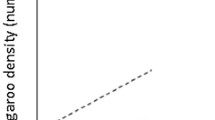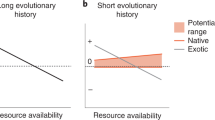Summary
A two-yar survey of winter-germinating annual plants in southern Arizona indicates that species diversity declines consistently as a function of increasingly recent grazing by cattle. This finding conflicts with reports that predators enhance prey species diversity in some marine and terrestrial systems. Consideration of equilibrium and nonequilibrium models suggests, however, that enhanced diversity should occur only for open, multi-celled prey populations experiencing intermittant predation. These general conditions appear not to hold for the cattle-annual plant system.
Similar content being viewed by others
References
Addicott JF (1974) Predation and prey community structure: an experimental study of the effect of mosquito larvae on the protozoan communities of pitcher plants. Ecology 55:475–492
Beatley JC (1969) Biomass of desert winter annual plant populations in southern Nevada. Oikos 20:261–273
Brown JH, Reichman OJ, Davidson DW (1979) Granivory in desert ecosystems. Ann Rev Ecol Syst 10:201–227
Caswell H (1978) Predator-mediated coexistence: a nonequilibrium model. Amer Natur 112:127–154
Cody ML (1974) Competition and the structure of bird communities. Princeton NJ, Princeton Univ Press
Connell JH (1971) On the role of natural enemies in preventing competitive exclusion in some marine animals and in rain forest trees. In: PJ den Boer and GR Gradwell (eds) Dynamics of Populations, Wageningen, PUDOC, pp 298–312
Connell JH (1978) Diversity in tropical rainforests and coral reefs. Science 199:1302–1310
Darwin C (1890) On the origin of species by means of natural selection. Appleton and Co, New York
Diamond JM (1975) Assembly of species communites. In: ML Cody and JM Diamond (eds) Ecology and Evolution of Communities. Belknap Press of Harvard Univ Press, Cambridge, Mass
Emlen JM (1973) Ecology, an evolutionary approach. Addison-Wesley, Reading, Mass.
Epling C, Lewis H, Ball FM (1960) The breeding group and seed storage: a study in population dynamics. Evolution 14:238–255
Harper JL (1969) The roles of predation in vegetational diversity. Brookhaven Symp in Biology 22:48–62
Horn HS, MacArthur RH (1972) competition among fugitive species in a harlequin environment. Ecology 53:749–752
Hubbell SP (1979) Tree dispersion, abundance, and diversity in a tropical dry forest. Science 203:1299–1309
Huston M (1979) A general hypothesis of species diversity. Amer Natur 113:81–101
Hutchinson CE (1959) Homage to Santa Rosalia, or why are there so many kinds of animals? Amer Natur 93:145–159
Inouye RS, Byers GS, Brown JH (1981) Effects of predation and competition on survivorship, fecundity, and community structure of desert annuals. Ecology 61:1344–1351
Klickoff LG (1966) competitive response to moisture stress of a winter annual of the Sonoran Desert. American Midland Naturalist 75:383–391
Levins R, Culver D (1971) Regional coexistence of species and competition between rare species. Proc Nat Acad Sci (USA) 68:1246–1248
Levin DA, Kerster HW (1974) Gene flow in seed plants. Evol Biol 7:139–220
Lubchenco J (1978) Plant species diversity in a marine intertidal community: importance of herbivore food preference and algal competitive abilities. Amer Natur 112:23–39
Lubchenco J, Menge BA (1978) Community development and persistence in a low rocky intertidal zone. Ecol Monogr 48:67–94
MacArthur RH (1958) Population ecology of some warblers of northeastern coniferous forests. Ecology 39:599–619
MacArthur RH (1972) Geographical ecology. Harper and Row, New York
MacArthur RH, Levins R (1967) The limiting similarity, convergence, and divergence of coexisting species. Amer Natur 101:377–385
MacArthur RH, Wilson EO (1967) The theory of island biogeography. Princeton Univ Press, Princeton, NJ
May RM (1973) Stability and complexity in model ecosystems. Princeton Univ Press, Princeton, NJ
Mott JJ, McComb AJ, (1974) Patterns in annual vegetation and soil microrelief in an arid region of western Australia. J Ecol 62:115–126
Mulroy TW, Rundel PW (1977) Annual plants: adaptations to desert environments. Bioscience 27:109–114
Paine RT (1966) Food web complexity and species diversity. Amer Natur 100:65–75
Paine RT (1977) Controlled manipulations in the marine intertidal zone and their contributions to ecological theory. In: CE Goulden (ed) Changing scenes in the natural sciences 1776–1976. Acad Nat Sci, Philadelphia, Pa
Paine RT, Vadas RL (1969) The effects of grazing by sea urchins, Strongylocentrotus ssp., on benthic algal populations. Limnology and Oceanograph 14:710–719
Reichman OJ (1976) Effects of rodents on germination of desert annuals, IBP Desert Biome Res Memo 76-20
Sellers WD, Hill RH (1974) Arizona climate. Univ of Arizona Press, Tucson
Shreve F, Wiggins IL (1964) Vegetation and flora of the Sonoran Desert. Stanford Univ Press, Stanford, Calif
Steenbergh WF, Warren PL (1977) Preliminary ecological investigation of natural community status at Organ Pipe Cactus National Monument. Coop Nat Park Res Studies Unit Tech Report No 3, Univ of Arizona
Tevis LR (1958a) A population of desert ephemerals germinated by less than one inch of rain. Ecology 39:688–695
Tevis LR (1958b) Germination and growth of ephemerals induced by sprinkling a sandy desert. Ecology 39:681–688
Tevis LR (1958c) Interrelations between the harvester ant Veromessor pergandei (Mayr) and some desert ephemerals. Ecology 39:695–704
Warren PL (1979) Plant and rodent communities of Organ Pipe Cactus National Monument. MA Thesis, Univ of Arizona, Tucson
Went FW (1973) Competition among plants. Proc Natn Acad Sci (USA) 70:585–590
Went FW, Westergaard M (1949), Ecology of desert plants. III. Development of plants in the Death Valley National Monument, California. Ecology 30:26–38
Yodzis P (1977) Harvesting and limiting similarity. Amer Natur 111:833–843
Author information
Authors and Affiliations
Rights and permissions
About this article
Cite this article
Waser, N.M., Price, M.V. Effects of grazing on diversity of annual plants in the Sonoran Desert. Oecologia 50, 407–411 (1981). https://doi.org/10.1007/BF00344983
Received:
Issue Date:
DOI: https://doi.org/10.1007/BF00344983




